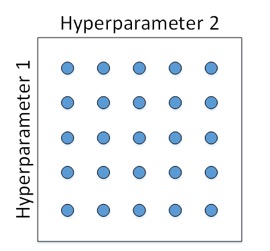一、调试处理
超参数
α:学习因子
β:动量梯度下降因子
β1,β2,ε:Adam算法参数
layers:神经网络层数
hidden units:各隐藏层神经元个数
learning rate decay:学习因子下降参数
mini-batch size:批量训练样本包含的样本个数
重要性
通常来说,学习因子αα是最重要的超参数,也是需要重点调试的超参数。动量梯度下降因子β、各隐藏层神经元个数#hidden units和mini-batch size的重要性仅次于αα。然后就是神经网络层数#layers和学习因子下降参数learning rate decay。最后,Adam算法的三个参数β1,β2,ε一般常设置为0.9,0.999和10−810−8,不需要反复调试。
调整
传统的机器学习,对每个超参数等间隔选取,然后,分别使用不同点对应的参数组合进行训练,最后根据验证集上的表现好坏,来选定最佳的参数
深度网络模型中,一般随机选取。因为每个参数的重要程度不同。例如上面对每个参数只有5种取值,下面这个则有25种情况。
二、 Using an appropriate scale to pick hyperparameters
非均匀刻度尺

α、β
关于β的说明:假设β从0.9000变化为0.9005,那么1/1−β基本没有变化。但假设ββ从0.9990变化为0.9995,那么1/1−β前后差别1000。β越接近1,指数加权平均的个数越多,变化越大。所以对β接近1的区间,应该采集得更密集一些。
三、 Batch Normalization
标准化输入
在训练神经网络时,标准化输入可以提高训练的速度。方法是对训练数据集进行归一化的操作,即将原始数据减去其均值μ后,再除以其方差σ2。
batch norm

一般进一步处理
Normalizing inputs使所有输入的均值为0,方差为1。而Batch Normalization可使各隐藏层输入的均值和方差为任意值。实际上,从激活函数的角度来说,如果各隐藏层的输入均值在靠近0的区域即处于激活函数的线性区域,这样不利于训练好的非线性神经网络,得到的模型效果也不会太好。
四、 Why does Batch Norm work
如果发生covariate shift,因为batch norm的作用,隐藏层的输出均值和方差仍不变,则其他参数会更加稳定,模型在其他样本上也会有不错的表现。
从另一个方面来说,Batch Norm也起到轻微的正则化(regularization)效果。具体表现在:
- 每个mini-batch都进行均值为0,方差为1的归一化操作
- 每个mini-batch中,对各个隐藏层的Z[l]添加了随机噪声,效果类似于Dropout
- mini-batch越小,正则化效果越明显
五、 softmax回归
介绍
对于二分类问题,网络的输出层只有一个神经单元,输出值表示预测输出为正类的概率
,
则判断为正类,
则判断为负类。
对于多分类问题,用C表示种类个数,神经网络中输出层就有C个神经元,其中每个神经元的输出依次对应属于该类的概率。为了处理多分类问题,我们一般使用Softmax回归模型。其激活函数如下:损失函数
六、深度学习框架
- Caffe
- Keras
- CNTK
- DL4J
- Lasagne
- mxnet
- PaddlePaddle
- Tensorflow
- Theano
- Torch
选择框架的标准:
- ease of programming
- running speed
- truly open
七、编程作业
- create placeholder
def create_placeholders(n_x, n_y):"""Creates the placeholders for the tensorflow session.Arguments:n_x -- scalar, size of an image vector (num_px * num_px = 64 * 64 * 3 = 12288)n_y -- scalar, number of classes (from 0 to 5, so -> 6)Returns:X -- placeholder for the data input, of shape [n_x, None] and dtype "float"Y -- placeholder for the input labels, of shape [n_y, None] and dtype "float"Tips:- You will use None because it let's us be flexible on the number of examples you will for the placeholders.In fact, the number of examples during test/train is different."""### START CODE HERE ### (approx. 2 lines)X = tf.placeholder(tf.float32, [n_x, None], name="X")Y = tf.placeholder(tf.float32, [n_y, None], name='Y')### END CODE HERE ###return X, Y
- initializing the parameters
# GRADED FUNCTION: initialize_parametersdef initialize_parameters():"""Initializes parameters to build a neural network with tensorflow. The shapes are:W1 : [25, 12288]b1 : [25, 1]W2 : [12, 25]b2 : [12, 1]W3 : [6, 12]b3 : [6, 1]Returns:parameters -- a dictionary of tensors containing W1, b1, W2, b2, W3, b3"""tf.set_random_seed(1) # so that your "random" numbers match ours### START CODE HERE ### (approx. 6 lines of code)W1 = tf.get_variable("W1", [25,12288], initializer = tf.contrib.layers.xavier_initializer(seed = 1))b1 = tf.get_variable("b1",[25,1],initializer=tf.zeros_initializer())W2 = tf.get_variable("W2", [12, 25], initializer = tf.contrib.layers.xavier_initializer(seed=1))b2 = tf.get_variable("b2", [12, 1], initializer = tf.zeros_initializer())W3 = tf.get_variable("W3", [6, 12], initializer = tf.contrib.layers.xavier_initializer(seed=1))b3 = tf.get_variable("b3", [6, 1], initializer = tf.zeros_initializer())### END CODE HERE ###parameters = {"W1": W1,"b1": b1,"W2": W2,"b2": b2,"W3": W3,"b3": b3}return parameters
- forward propagation in tensorflow
# GRADED FUNCTION: forward_propagationdef forward_propagation(X, parameters):"""Implements the forward propagation for the model: LINEAR -> RELU -> LINEAR -> RELU -> LINEAR -> SOFTMAXArguments:X -- input dataset placeholder, of shape (input size, number of examples)parameters -- python dictionary containing your parameters "W1", "b1", "W2", "b2", "W3", "b3"the shapes are given in initialize_parametersReturns:Z3 -- the output of the last LINEAR unit"""# Retrieve the parameters from the dictionary "parameters"W1 = parameters['W1']b1 = parameters['b1']W2 = parameters['W2']b2 = parameters['b2']W3 = parameters['W3']b3 = parameters['b3']### START CODE HERE ### (approx. 5 lines) # Numpy Equivalents:Z1 = tf.add(tf.matmul(W1,X),b1) # Z1 = np.dot(W1, X) + b1A1 = tf.nn.relu(Z1) # A1 = relu(Z1)Z2 = tf.add(tf.matmul(W2,A1),b2) # Z2 = np.dot(W2, a1) + b2sA2 = tf.nn.relu(Z2) # A2 = relu(Z2)Z3 = tf.add(tf.matmul(W3,A2),b3) # Z3 = np.dot(W3,Z2) + b3### END CODE HERE ###return Z3
- compute cost
# GRADED FUNCTION: compute_costdef compute_cost(Z3, Y):"""Computes the costArguments:Z3 -- output of forward propagation (output of the last LINEAR unit), of shape (6, number of examples)Y -- "true" labels vector placeholder, same shape as Z3Returns:cost - Tensor of the cost function"""# to fit the tensorflow requirement for tf.nn.softmax_cross_entropy_with_logits(...,...)logits = tf.transpose(Z3)labels = tf.transpose(Y)### START CODE HERE ### (1 line of code)cost = tf.reduce_mean(tf.nn.softmax_cross_entropy_with_logits(logits=logits,labels=labels))### END CODE HERE ###return cost
- backward propagation & parameter updates
#For instance, for gradient descent the optimizer would be:optimizer = tf.train.GradientDescentOptimizer(learning_rate = learning_rate).minimize(cost)#To make the optimization you would do:_ , c = sess.run([optimizer, cost], feed_dict={X: minibatch_X, Y: minibatch_Y})

